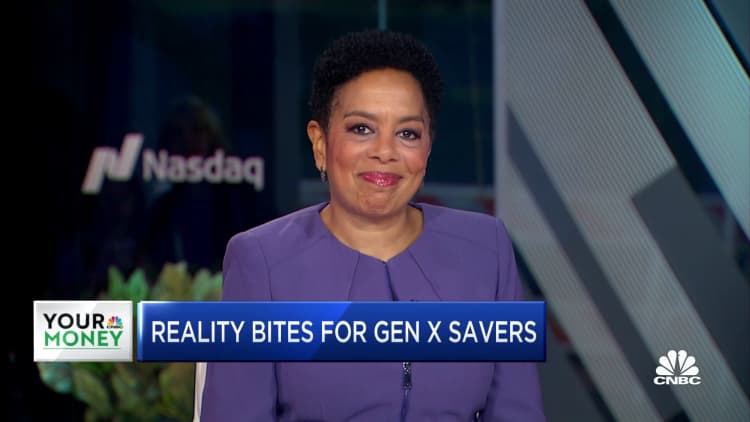People age 50 and older are nearing the final stretch when it comes to planning for retirement.
Yet, 62% of those in that age cohort have not consulted a professional to help plan for their golden years, according to a recent survey from AARP.
The top answer for why, with 41%, is they prefer to handle the financial planning themselves or to leave it to their spouse.
That was followed by 35% who said they don't have much retirement savings and 30% who say they cannot afford a financial professional, the December survey of 1,002 adults found.
More from Personal Finance:
Deflation vs. disinflation: What's the difference?
Americans are racking up more 'phantom debt'
56 million Americans have been in credit card debt for over a year
The median age workers 50 and older expect to retire is 67, according to the Transamerica Center for Retirement Studies, while some individuals in that age cohort are already transitioning into retirement.
Transamerica's research also found retirement often does not happen on time, with 56% of retirees hanging up their hats sooner than planned. Meanwhile, 37% retired when they expected, while 7% retired later.
Many Gen Xers are struggling to save for retirement
For some pre-retirees who are members of Gen X, the oldest of whom turn 59 this year, low retirement savings levels may pose a challenge.
The typical Gen X household has just $40,000 in retirement savings, according to research from the National Institute on Retirement Security.
The bottom half of Gen X earners only have a few thousand dollars saved toward retirement, the research found.

Those who fall in the bottom half typically do not have access to a workplace retirement plan, noted Dan Doonan, executive director at the NIRS. Encouraging financial literacy may help to improve those balances, he said.
"If you have so much savings at retirement, how much income does that produce?" Doonan said. "I think knowledge around that area is probably not very strong."
For example, based on a 4% withdrawal rule, $100,000 in retirement savings means you would expect about $4,000 in annual income.
"I don't think it's widely understood that it's that low," Doonan said.
'Everybody should have a financial plan'
Another obstacle is the way the financial industry is structured, which may lead prospective retirees to be reluctant to pay for advice from their already-low retirement balances, he noted. Meanwhile, financial professionals are typically better rewarded for serving more affluent clients.
However, people who have lower assets or income should not necessarily be discouraged from seeking professional advice.
"Everybody should have a financial plan because it helps you map out the terrain for the rest of your life," said Daphne Jordan, a certified financial planner and board chair at the National Association of Personal Financial Advisors, or NAPFA.
Some financial planners are compensated based on hourly rates or flat rates, and that information should be readily available on their website, noted Jordan, who is also a senior wealth advisor at Pioneer Wealth Management Group in Austin, Texas.
It is important to check whether a professional has the certified financial planner designation, Jordan said, as they are trained to look at your entire financial picture, including areas such as your cash flow, insurance coverage and Social Security claiming strategy. Advisors who are affiliated with NAPFA operate on a fee-only basis, which means they are not paid via commissions, nor do they sell financial products.
Search tools provided by NAPFA, the CFP Board or the XY Planning Network may help identify potential financial professional matches. Importantly, prospective clients should also cross check the professional's names with the U.S. Securities and Exchange Commission and FINRA websites to see if they have any complaints against them.
Before selecting one professional, talk to a few prospects to see who you vibe with the most, Jordan advised.
"For the amount that you pay for cable in a year, you can pay a financial planner, a professional certified financial planner, and then you'll get that peace of mind when it comes to your hard-earned money," Jordan said.
While certified financial planners are required to put the interests of their clients first, that is not true for all financial professionals. Yet the AARP survey found most individuals — 89% — who either work with a financial professional or plan to expect they will be acting in their best interests.
Whether protections should be expanded is currently being debated in Washington, with a Wednesday Capitol Hill hearing on a proposed fiduciary rule that would increase protections for retirement advice. The SEC already has a best interest rule, while the Department of Labor's proposal would expand those protections to other areas not regulated by the SEC, particularly with the sale of products.
"It's basically just saying that look, whether you want to recommend somebody invest in a stock or a bond, or a mutual fund or an insurance product, that's fine," said David Certner, legislative policy director at AARP, which supports the proposal. "But the advisor needs to be doing it in the best interest of their clients."
Don't miss these stories from CNBC PRO:
- There's one stock Wall Street loves so much for 2024 that five analysts in one day picked it as their favorite
- Morgan Stanley names its top stocks for 2024, including this streaming giant
- Investing tips from Warren Buffett to start the new year on the right foot
- Goldman sees a 50% gain ahead for this Chinese electric vehicle stock, initiates with buy rating
- 'Twice as cheap': These stocks' discount to the S&P 500 is double its average, Ritholtz's Brown says


